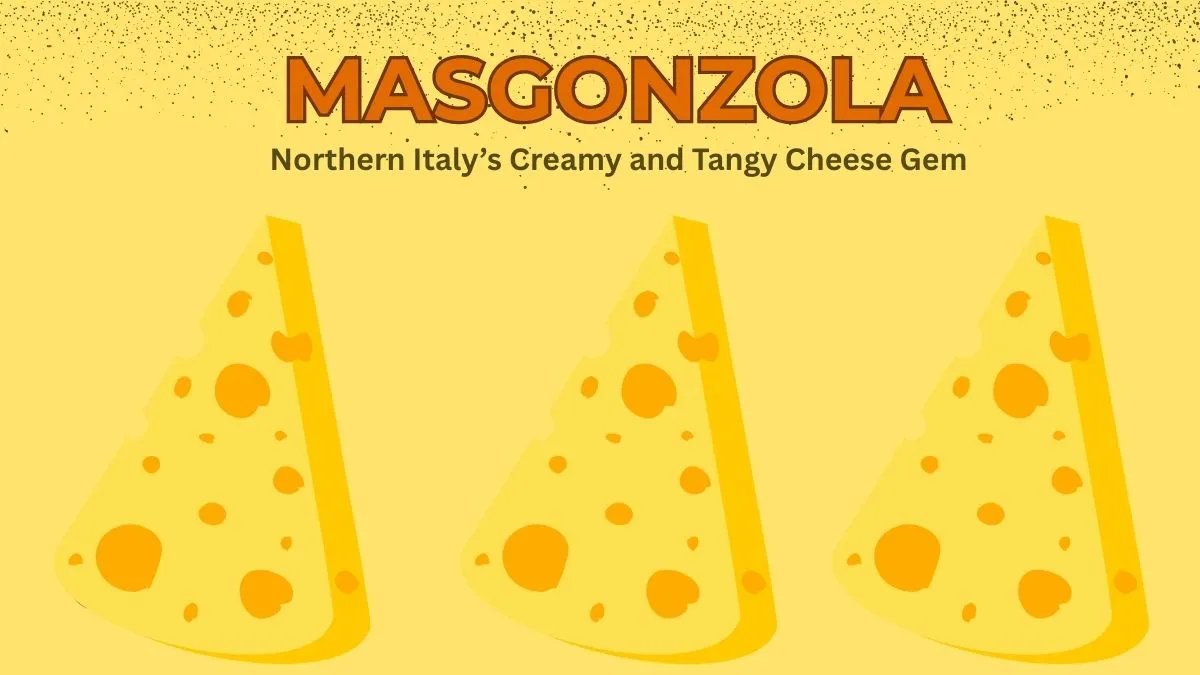FOODS AND DRINKS
Masgonzola: Northern Italy’s Creamy and Tangy Cheese Gem

Masgonzola is a luxurious Italian cheese that unites mascarpone’s creaminess with Gorgonzola Dolce’s tang, offering a refined balance that elevates both traditional and modern culinary creations.
Introduction
Cheese has long been a cornerstone of Italian gastronomy, offering a spectrum of flavors from delicate and creamy to bold and pungent. Among these treasures, Masgonzola stands out as a distinctive creation. This luxurious cheese blends the silky richness of mascarpone with the mild, tangy complexity of Gorgonzola Dolce, producing a soft, marbled delicacy that is as elegant as it is versatile. Originating from Northern Italy, it embodies centuries of Italian cheesemaking artistry, reimagined in a way that balances tradition with innovation.
Where Tradition Meets Experimentation
Italy counts more than 400 cheeses with official recognition, but it is unusual because it is the result of intentional craftsmanship rather than centuries of slow evolution.
It was conceived in the Lombardy, Piedmont corridor, a fertile northern plain where both mascarpone and Gorgonzola first emerged:
- Mascarpone arose from cream thickened by gentle heating and acidification, creating a sweet, silken base that later defined desserts like tiramisù.
- Gorgonzola Dolce, in contrast, has a history reaching back to the Middle Ages, its blue veins formed by Penicillium roqueforti cultures and its texture mellowed by careful aging.
By marrying these two, Italian affineurs created a cheese that isn’t accidental but intentional: Mascarpone was crafted to soften the intimidating punch of blue cheese while preserving the luxury of mascarpone’s cream.
A Flavor Profile That Refuses Extremes
Where Gorgonzola Piccante dares with sharpness, Masgonzola whispers. It aims for equilibrium, not dominance.
- Texture: Unctuous, spreadable, with pale cream streaked by delicate turquoise veins.
- Taste: The mascarpone’s butterfat rounds out every bite, tempering the blue mold’s tang into a soft hum rather than a shout.
- Aroma: Faintly mushroomy, lightly sweet, never aggressive.
This equilibrium makes Masgonzola a “gateway blue”, a cheese capable of converting skeptics, while still intriguing those with refined palates.
Culinary Roles
It adapts to context, equally at home on a farmhouse table in Bergamo or as a garnish in Milanese fine dining.
On the Cheese Board
- Drizzled with chestnut honey, it becomes almost dessert-like.
- Paired with poached pears or roasted figs, it hits the sweet–savory axis.
- Spread on walnut bread, its creamy tang finds an earthy counterpoint.
In Traditional Italian Dishes
- Melted into risotto al porcini, it deepens the woodland flavors.
- Folded into fresh pasta sauces, it enriches without overwhelming.
- As a pizza bianca topping, layered under speck and arugula, it delivers subtle decadence.
In Contemporary Fusion
- A crostini base topped with balsamic-caramelized onions.
- Incorporated into a modern cheesecake swirl with dark chocolate.
- As a burger accent, cutting through beef richness without bitterness.
This versatility is what sets Masgonzola apart: it performs both as a star ingredient and a supporting note.

Nutritional Insights Beyond the Basics
Most articles reduce cheese nutrition to protein and calcium. But it is interesting because of its hybrid composition:
- Its butterfat content is elevated from the mascarpone base, giving it a caloric richness closer to dessert cheeses.
- The blue veining introduces probiotics (Penicillium cultures) that may support gut microbiota, something mascarpone alone cannot claim.
- Its balance of short-chain fatty acids provides digestibility advantages compared to firmer aged blues.
Thus, while indulgent, Masgonzola occupies a nutritional middle ground—richer than soft cream cheeses but gentler than pungent blues.
Comparing Masgonzola with Its Relatives
| Cheese | Texture | Flavor Signature | Culinary Sweet Spot |
| Masgonzola | Soft, marbled | Creamy with gentle tang | Risotto, spreads, desserts |
| Mascarpone | Silky, uniform | Buttery, subtly sweet | Tiramisu, creamy sauces |
| Gorgonzola Dolce | Semi-soft, veined | Mild blue, earthy | Pizza, risotto, polenta |
| Gorgonzola Piccante | Firm, crumbly | Sharp, spicy, pungent | Grilled meats, bold cheese pairings |
Masgonzola sits strategically between the extremes: richer than mascarpone, friendlier than Piccante.
A Cultural Symbol of Northern Italian Innovation
It is not just a cheese; it is a philosophical gesture. In regions like Lombardy, where dairy artistry runs deep, cheesemakers have historically embraced both fidelity to tradition and bold innovation.
By combining two icons, Masgonzola represents a culinary bridge:
- For Italians, it reinterprets the familiar in surprising ways.
- For international gourmands, it provides an accessible entry point into the more intimidating world of mold-ripened cheeses.
It has become emblematic of Northern Italy’s willingness to elevate comfort into luxury, a theme central to its food culture.
Selecting, Storing, and Serving
To appreciate Masgonzola fully, selection and handling matter:
- Look for: Distinct marbling, a supple body, and a sheen that indicates freshness.
- Avoid: Excess liquid pooling in packaging, which signals breakdown.
- Storage: Wrap in wax or parchment to let the cheese breathe, then enclose in a container.
- Serving tip: Let it rest at room temperature for 30 minutes before serving, its cream base blossoms only when softened.
FAQs
Q1: How is Mascarpone different from simply mixing mascarpone and Gorgonzola at home?
Commercial Mascarpone is cultured and aged as a single cheese, allowing flavors to marry and textures to integrate. Mixing at home produces contrast, not harmony.
Q2: Does Masgonzola age like other blue cheeses?
No. Its mascarpone base limits long aging, beyond a few weeks, the fat structure destabilizes. It is crafted for fresh-to-mid consumption, not cellaring.
Q3: What wines pair best with Mascarpone?
Light dessert wines like Moscato d’Asti enhance their creaminess, while earthy Nebbiolo offers contrast. Avoid overly tannic reds; they overpower their delicacy.
Conclusion
It is more than a hybrid; it is a curated dialogue between two cheese traditions. By tempering Gorgonzola Dolce’s tang with mascarpone’s silken fat, it becomes a cheese that seduces without intimidating, adapts without losing character, and elevates without pretension.
-

 BIOGRAPHY7 months ago
BIOGRAPHY7 months agoBehind the Scenes with Sandra Orlow: An Exclusive Interview
-

 HOME1 year ago
HOME1 year agoDiscovering Insights: A Deep Dive into the //vital-mag.net blog
-

 HOME1 year ago
HOME1 year agoSifangds in Action: Real-Life Applications and Success Stories
-

 BIOGRAPHY1 year ago
BIOGRAPHY1 year agoThe Woman Behind the Comedian: Meet Andrew Santino Wife




























